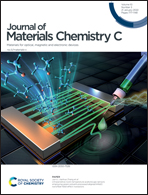Large enhancement of ferroelectric polarization in Hf0.5Zr0.5O2 films by low plasma energy pulsed laser deposition†
Abstract
The ferroelectric phase of HfO2 is generally stabilized in polycrystalline films, which typically exhibit the highest polarization when deposited using low oxidizing conditions. In contrast, epitaxial films grown by pulsed laser deposition show low or suppressed polarization if a low oxygen pressure is used. Epitaxial films are essential to better understand physical properties, and obtaining films that have intrinsic polarization is of great importance. In order to advance towards this objective, we have carried out a systematic study of the epitaxial growth of Hf0.5Zr0.5O2 combining inert Ar gas with oxidizing O2 gas. This allows us to control the oxidizing conditions (through O2 partial pressure) and the energy of the pulsed laser deposition plasma (through the total pressure of O2 and Ar). A pressure of Ar high enough to significantly reduce plasma energy and that of O2 low enough to reduce oxidation conditions are found to allow a large increase in ferroelectric polarization up to about 30 μC cm−2, representing an increase of around 50% compared to films grown by conventional pulsed laser deposition. This simple growth process, with high impact in the development of ferroelectric HfO2, can be also beneficial in the growth of thin films of other materials by pulsed laser deposition.



 Please wait while we load your content...
Please wait while we load your content...